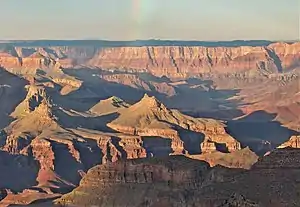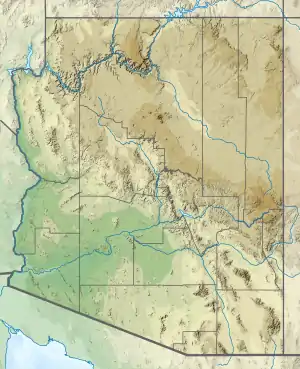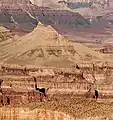Solomon Temple (Grand Canyon)
Solomon Temple is a 5,121-foot-elevation (1,561 meter) summit located in the Grand Canyon, in Coconino County of northern Arizona, USA.[2] It is situated four miles north of Moran Point, 3.5 miles east of Newberry Butte, and 1.5 mile southeast of Rama Shrine, its nearest higher neighbor. Topographic relief is significant as it rises 2,500 feet (760 meters) above the Colorado River in less than one mile.
| Solomon Temple | |
|---|---|
 Solomon Temple centered in bullseye. Southwest aspect, from Grandview Point. | |
| Highest point | |
| Elevation | 5,121 ft (1,561 m) [1] |
| Prominence | 661 ft (201 m) [1] |
| Parent peak | Rama Shrine (6,406 ft)[1] |
| Isolation | 1.41 mi (2.27 km) [1] |
| Coordinates | 36°03′26″N 111°54′56″W [2] |
| Geography | |
 Solomon Temple Location in Arizona  Solomon Temple Solomon Temple (the United States) | |
| Location | Grand Canyon National Park Coconino County, Arizona, US |
| Parent range | Kaibab Plateau Colorado Plateau |
| Topo map | USGS Cape Royal |
| Geology | |
| Type of rock | limestone, sandstone, shale |
Solomon Temple was named after historical king Solomon by geologist François E. Matthes, following Clarence Dutton's practice of naming geographical features in the Grand Canyon after mythological deities and heroic figures.[3][4] This feature's name was officially adopted in 1906 by the U.S. Board on Geographic Names.[2]
Solomon Temple is a butte composed of Mississippian Redwall Limestone, which overlays shale of the Cambrian Tonto Group.[5] The Solomon Temple Member of the Dox Formation is so named because of exposures 2.4 kilometers northeast of this butte.[6]
According to the Köppen climate classification system, Solomon Temple is located in a Cold semi-arid climate zone.[7]
See also
Gallery
References
- "Solomon Temple - 5,121' AZ". Lists of John. Retrieved 2021-01-22.
- "Solomon Temple". Geographic Names Information System. United States Geological Survey. Retrieved 2021-01-22.
- N.H. Darton, Story of the Grand Canyon of Arizona, 1917, page 81.
- J. Donald Hughes, The Story of Man at Grand Canyon, 1967, Grand Canyon Natural History Association, K.C. Publications, page 106.
- N.H. Darton, Story of the Grand Canyon of Arizona, 1917, page 59.
- Gwendolyn W. Luttrell, Marilyn L. Hubert, Cynthia R. Murdock, Lexicon of New Formal Geolocic Names of the United States 1981-1985, 1991, U.S. Department of the Interior, Geological Survey; Washington, D.C., page 299.
- Peel, M. C.; Finlayson, B. L.; McMahon, T. A. (2007). "Updated world map of the Köppen−Geiger climate classification". Hydrol. Earth Syst. Sci. 11. ISSN 1027-5606.
External links
| Wikimedia Commons has media related to Solomon Temple. |
- Weather forecast: National Weather Service

